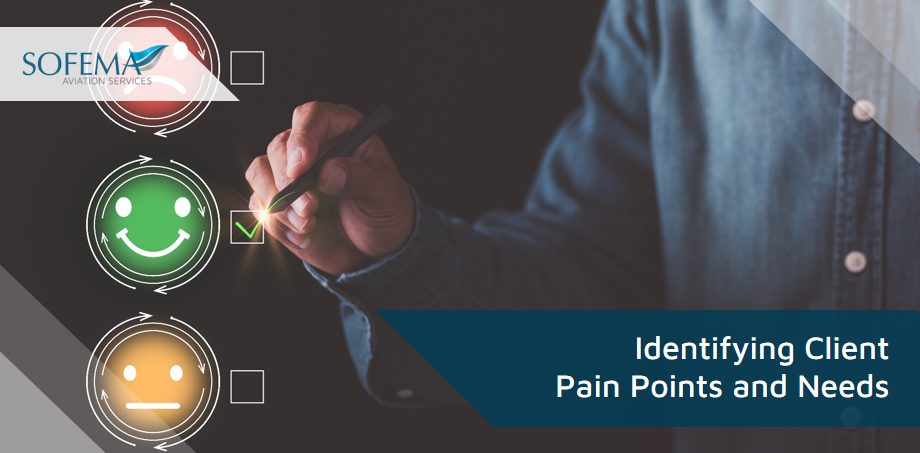Sofema Aviation Services (SAS) www.sassofia.com considers key issues related to understanding Client Pain Points.
Introduction
Identifying client pain points and needs is a dynamic and ongoing process that requires strategic approaches, effective communication, and data-driven insights. By addressing the challenges and implementing best practices outlined in this document, organizations can develop more accurate and impactful solutions, leading to enhanced client satisfaction and long-term partnerships. Understanding and addressing client pain points will enhance client satisfaction and foster long-term relationships. Here we explore the challenges and issues in identifying client pain points and needs and consider best practices to address them effectively.
Challenges and Issues in Identifying Client Pain Points and Needs
- Lack of Clear Communication
o Clients may struggle to articulate their needs and pain points clearly, leading to misunderstandings and inadequate solutions.
o Ensuring effective communication channels to facilitate clear and open dialogue with clients.
- Diverse and Evolving Needs
o Clients’ needs can vary widely and evolve over time, making it difficult to maintain up-to-date understanding.
o Keeping pace with the changing requirements and ensuring solutions remain relevant and effective.
- Complex Organizational Structures
o In larger organizations, identifying the right stakeholders and decision-makers can be challenging.
o Navigating complex organizational structures to engage with the appropriate personnel.
- Insufficient Data and Insights
o Limited access to comprehensive data and insights about client operations and challenges can hinder the accurate identification of needs.
o Gathering and analyzing relevant data to inform decision-making and solution development.
- Resistance to Change
o Clients may be resistant to acknowledging or addressing specific pain points, especially if they involve significant changes.
o Overcoming resistance and fostering a culture of openness to change and improvement.
Best Practices for Identifying Client Pain Points and Needs
- Conduct Thorough Needs Assessments
o Utilize structured needs assessment tools and methodologies, such as surveys, interviews, and workshops.
o Gain a comprehensive understanding of client challenges and requirements through detailed and systematic data collection.
- Foster Open Communication Channels
o Establish regular and transparent communication with clients through meetings, feedback sessions, and collaborative platforms.
o Build trust and ensure a continuous flow of information that helps in identifying and addressing pain points promptly.
- Engage with Key Stakeholders
o Practice: Identify and involve key stakeholders across various levels of the client organization in the needs assessment process.
o Ensure a holistic understanding of needs from different perspectives within the organization, leading to more effective solutions.
- Leverage Data Analytics
o Utilize data analytics tools to gather and analyze client data, including operational metrics, performance indicators, and feedback.
o Make informed decisions based on data-driven insights, leading to more precise identification of pain points and needs.
- Provide Tailored Solutions
o Develop customized solutions that specifically address the identified pain points and needs of each client.
o Enhance client satisfaction and effectiveness of solutions by ensuring they are directly relevant to the client’s context.
- Maintain Continuous Engagement
o Practice: Implement ongoing engagement strategies, such as regular check-ins, updates, and follow-ups, to monitor evolving needs.
o Stay attuned to changes in client requirements and ensure solutions remain effective over time.
- Encourage Client Feedback and Participation
o Actively solicit feedback from clients and involve them in the development and refinement of solutions.
o Foster a collaborative relationship and ensure solutions are aligned with client expectations and preferences.
- Promote a Culture of Continuous Improvement
o Encourage clients to embrace continuous improvement by highlighting the benefits and providing support for change initiatives.
o Overcome resistance to change and promote a proactive approach to addressing pain points and improving operations.
Next Steps
Follow this link to our Library to find & Download related documents for Free.
Sofema Aviation Services (www.sassofia.com) and Sofema Online (www.sofemaonline.com) offer multiple soft skills training, including the following course: Aviation Leadership and Management Skills Development – Developing Negotiation Skills – 1 Day. For additional details or if you have any questions, please email team@sassofia.com.
Tags:
change process. Resistance to Change, Data Analytics in Aviation, Client Feedback, Leadership Development, Customized Solutions, Stakeholder Engagement, Data-Driven Solutions, Client Pain Points, Effective Communication Strategies, continuous improvement, Aircraft, sales training, Training Needs Assessment (TNA), Negotiation Skills, Soft Skills, Client satisfaction, SAS blogs, Aviation Leadership, aviation





